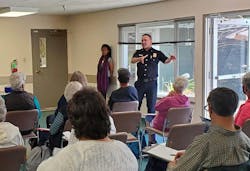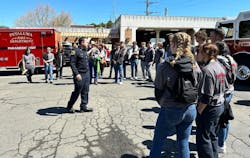The Role of Executive Fire Officers in Building a Resilient Community
In the ever-evolving landscape of emergency services, the role of executive fire officers extends beyond the immediate scope of fire response and EMS. As leaders, these officers must embrace a broader perspective that encompasses their entire community. The concept of resilience, particularly within the framework of the whole-community approach, underscores the importance of this expanded role.
Multifaceted responsibilities of executive fire officers challenge them to handle fire response and EMS as well as foster community resilience. Key strategies and the complexities of modern leadership are crucial to the professional development of these people.
Beyond traditional paradigms
Community resilience is a cornerstone of effective emergency management. It’s about a community’s capability to endure, adapt to and bounce back from disruptions, whether natural disasters, health crises or socio-economic challenges. Resilient communities aren’t just better equipped to handle emergencies; they also possess a sense of hope and optimism for the future. The executive fire officer’s role is essential and pivotal in steering a community toward this resilience, which necessitates a departure from traditional fire service paradigms.
The shift in perspective demands a deep understanding of community dynamics and the elements that bolster resilience. Executive fire officers aren’t just required but encouraged to step out of the boundaries of their organization and actively engage with the broader community. This involves building relationships, grasping community needs and leveraging local resources. By adopting a holistic approach, fire service leaders can instill a culture of preparedness and resilience that benefits all community members.
Understanding community resilience
Community resilience refers to the capability of a community to adapt to changing conditions, withstand disruptions and recover swiftly from emergencies.
FEMA defines resilience as the capability to adapt, resist and rapidly recover from disruptions because of emergencies, including natural disasters and social and economic stressors, such as health issues, food insecurity and homelessness. This broad definition requires a comprehensive approach to emergency management, including prevention, preparedness, response and recovery efforts, to provide reassurance and confidence in the community’s preparedness.
Understanding each community’s unique characteristics and needs is crucial to building resilience. This involves conducting thorough assessments to identify vulnerabilities and strengths. Executive fire officers play a vital role in these assessments, utilizing their knowledge and experience to guide the development of tailored resilience strategies. Focusing on the community’s immediate and long-term needs can help to create robust systems that are capable of handling a wide range of emergencies.
Further, resilience isn’t a static goal but a continuous process of improvement and adaptation. Communities must regularly evaluate and update their resilience plans to address emerging threats and changing circumstances. Executive fire officers must lead this ongoing effort, fostering a culture of continuous learning and adaptation within their organization and the broader community. This proactive approach ensures that communities remain resilient despite evolving challenges.
Partnerships with CBOs
Building resilient communities requires strong partnerships with community-based organizations (CBOs). These nonprofit groups work at the local level to improve residents’ lives. Their mission is to tackle issues that are important to the community, such as healthcare, education, housing and economic development. By partnering with CBOs, executive fire officers can leverage local knowledge and resources to enhance community resilience.
CBOs embed deeply in their community and establish trust with residents. This trust is crucial when implementing resilience-building initiatives, because it facilitates community buy-in and participation.
Executive fire officers should seek out and actively engage CBOs to identify community needs, develop tailored strategies and mobilize resources. This collaboration ensures that resilience efforts are grounded in the community’s realities and are more likely to succeed.
Executive fire officers provide leadership and support in these partnerships. These people can offer expertise in emergency management, coordinate response efforts and help CBOs to access additional resources. By working together, fire service leaders and CBOs can create a comprehensive resilience approach that addresses immediate and long-term challenges. These partnerships strengthen the social fabric of the community, which makes it more resilient to future emergencies.
Whole-community approach
The whole-community approach that’s advocated by FEMA emphasizes the involvement of all community sectors in resilience-building efforts. The approach is based on three core principles: understanding and meeting the actual needs of the whole community; engaging and empowering all parts of the community; and strengthening what works well in the community on a daily basis. These principles guide executive fire officers’ strategic planning and operational activities, to ensure that resilience efforts are inclusive, comprehensive and effective.
Understanding and meeting the actual needs of the whole community require a deep engagement with community members. Executive fire officers must seek input from diverse groups regularly to ensure that resilience strategies address the full spectrum of community needs. This involves not only listening to community concerns but also involving residents in the planning and implementation of resilience initiatives. Fire service leaders can build a stronger, more cohesive community by fostering a sense of ownership and participation.
Engaging and empowering all parts of the community are crucial for effective resilience-building. This means recognizing and leveraging different community groups’ unique strengths and resources. To create a support network, executive fire officers must build partnerships with local organizations, businesses and other stakeholders. These collaborations can enhance the community’s capacity to respond to emergencies and recover quickly.
Leadership beyond the fire service
Traditional views of fire service leadership often focus on organizational operational excellence. However, to build resilient communities, executive fire officers must expand their leadership role to encompass the entire community. This shift involves developing community leadership skills, engaging with diverse community groups and fostering collaborative relationships. These skills and activities enable executive fire officers to navigate complex community dynamics and build effective partnerships.
Developing community leadership skills requires a commitment to continuous learning and personal growth. Executive fire officers must cultivate skills that are tied to strategic planning, communication, social and emotional intelligence, and stakeholder management. These skills enable executive fire officers to engage with community members effectively, to understand their needs and to build trust. By enhancing their leadership abilities, fire service leaders can better support their community in times of crisis and beyond.
Engaging with diverse community groups is another critical component of effective leadership. Communities comprise individuals and organizations that have varied backgrounds, experiences and perspectives. Executive fire officers must take the time to understand these differences and find common ground. This involves actively listening to community members, acknowledging their concerns and working collaboratively to develop solutions. By embracing diversity and inclusivity, fire service leaders can build stronger, more resilient communities.
Stakeholder engagement and social networks
Effective community leadership requires a deep understanding of stakeholder dynamics and the role of social networks in resilience-building. Stakeholders include individuals and groups that are vested in community resilience, from local government officials to private citizens and community organizations. Managing these relationships involves identifying and analyzing stakeholders, building trust and influence, and leveraging social networks.
Identifying and analyzing stakeholders is the first step in effective engagement. Executive fire officers must map out all relevant stakeholders and assess their interests, motivations and potential contributions to resilience efforts. Stakeholder analysis matrices are among the tools that can aid in this process, helping to visualize the complex web of relationships and influence within the community. By understanding who the key players are and what they care about, fire service leaders can mobilize support for resilience initiatives more effectively.
Building trust and influence with stakeholders is crucial for successful collaboration. Trust is built through consistent, transparent communication and a demonstrated commitment to addressing community concerns. Executive fire officers must be active listeners, provide transparent and honest information, and follow through on promises. By building solid relationships that are based on trust and mutual respect, fire service leaders can create a supportive network that enhances community resilience.
Lasting positive effects
The role of executive fire officers in building resilient communities is complex and multifaceted. It requires a shift to a broader, more inclusive approach from traditional operational leadership, to address the community’s diverse needs. Executive fire officers can lead their community toward greater resilience by embracing the whole-community approach, developing community leadership skills and fostering collaborative relationships. This expanded role not only enhances the effectiveness of emergency management efforts but also contributes to the overall well-being and sustainability of the community.
The evolution of the fire service leadership role underscores the need for executive fire officers to engage with their community meaningfully. By understanding and addressing the complexities of community resilience, these leaders can create lasting positive effects beyond the immediate scope of emergency response, to ensure a safer, more resilient future for all. The proactive involvement of executive fire officers in their community fosters a culture of preparedness and adaptability, which are critical components of resilience. This expanded leadership role requires ongoing education, relationship-building, and a commitment to understanding and addressing the unique challenges that the community faces. Through these efforts, executive fire officers can help to build a community that’s better equipped to handle emergencies and thrive in their aftermath.
About the Author

Chad Costa
Chad Costa is the assistant chief for the Petaluma, CA, Fire Department. With more than 26 years of fire service experience, he has worked in various organizations, including CAL FIRE, rural and semi-rural districts, and a city. As a battalion chief, Costa was the technology and communications battalion chief. He is now a rostered operations branch director for CalFire Team 1 and an alternate operations section chief trainee on California Interagency Team 5. Costa is an accredited Chief Fire Officer through the Center for Public Safety Excellence and has a bachelor’s degree in emergency services management, a master’s degree in fire service leadership, and a certificate in homeland security. Costa has also completed the Executive Chief Officer Program at the National Fire Academy. Costa is a member of the Firehouse Editorial Advisory Board.

